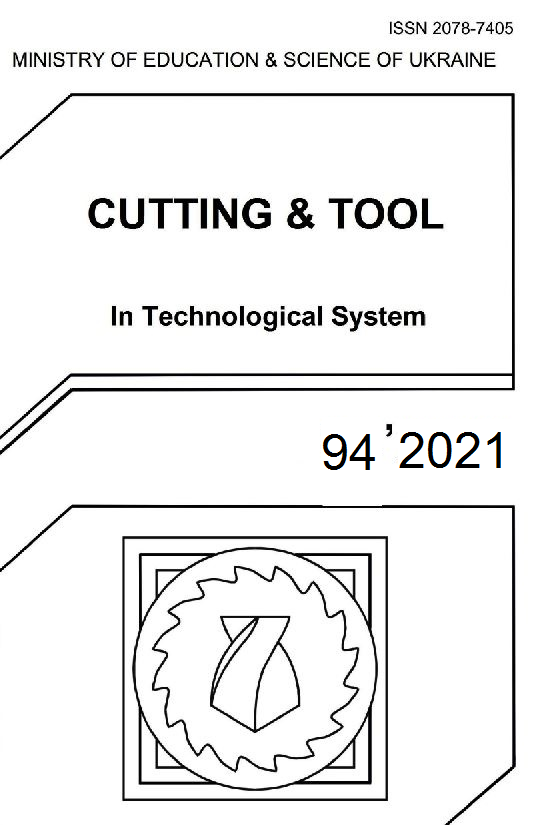AUTOMATIC CONTROL OF TEMPERATURE AND POWER CONDITIONS DURING ROUGH GRINDING OF SLABS
DOI:
https://doi.org/10.20998/2078-7405.2021.94.10Keywords:
rough grinding, slab grinding temperature control, aperiodic linkAbstract
The production of high-quality rolled products (slabs), the formation of its surface phase-structural composition, texture, stress state during rough grinding depends on the temperature in the area of contact between the wheel and the slab. During processing, due to geometric errors of the rolled surface, as well as due to local changes in hardness, periodic fluctuations of the instantaneous depth of cut occur, which can be determined indirectly by controlling one of the technological parameters, for example, the power spent on grinding, with subsequent recalculation it to online temperature values. The grinding temperature is described as a control object in the form of an aperiodic link. Computer simulation has confirmed the efficiency of the system for maintaining the specified temperature of slab grinding under various operating conditions that simulate the situations of real production.
References
Chirkov G. V. Matematicheskoe modelirovanie rezhimov rezaniya pri obrabotke materialov abrazivnymi instrumentami. Tekhnologiya mashinostroeniya. - 2004. - N 6. - pp.58–61
Lebedev V., Klimenko N., Uryadnikova I., Chumachenko T., Ovcharenko A. The definition of amount of heat released during metal cutting by abrasive grain and the contact temperature of the surface being grinded. Eastern-European Journal of Enterprise Technologies. 2016. No 5/7(83) 2016. –– pp. 43–50
Amitay G, Malkin S, Koren Y. Adaptive control optimization of grinding. trans. The American society of mechanical engineers. Vol. 103, No 1, pp. 131–136, Feb.1981
ACM – Adaptive Control & Monitoring. Adaptive feed rate control and monitoring. siemens.com 2008 https://assets.new.siemens.com/siemens/assets/api/uuid:9b3f1c78-227b-488b-84cc-e39127a0fec7/versionvondfmc-b10081-00acmde-72.pdf
Ken Thayer. Grinding theory and adaptive control optimization. Manufacture equipment and accessories. October 5. 2018 https://insights.globalspec.com/article/10106/grinding-theory-and-adaptive-control-optimization
Xiu-Shou H. The Research of a Practical Adaptive Control System for on External Cylindrical Grinding Process. In: Tobias S.A. (eds) Proceedings of the Twenty-Fifth International Machine Tool Design and Research Conference. Palgrave, London 1985. pp. 169–175. https://doi.org/10.1007/978-1-349-07529-4_18
Petrakov Iu.V. Adaptive control system for CNC machine-tools. 2016 Zavershennye nauchno-issledovatelskie raboty https://report.kpi.ua/en/node/1082
Larry Haftl. Adaptive Controls Save Tools and Time.Technology Advances Supercharge an Old Process. JAN 23, 2007 https://www.americanmachinist.com/machining-cutting/article/21896290/adaptive-controls-save-tools-and-time
Gao Y BSc, MSc, Jones B. Discrete Control System Model for the Traverse Grinding Process. Proceedings of the institution of Mechanical Engineers.Part 1:Journal of Systems and Control Engineering. First Published February 1, 1992, pp. 19–27
Zhan Qi Hu, Ming Li Xie, Yu Kun Li, Yi Tong Zhang. Research on Adaptive Control of Grinding Force of CNC Cams Grinder. Key Engineering Materials (Volume 416) September 2009. pp 360–364. https://doi.org/10.4028/www.scientific.net/KEM.416.360
Mingli Xie; Zhanqi Hu; Yitong Zhang. Research on Adaptive Control of Grinding Force of CNC Cam Grinder. International Workshop on Intelligent Systems and Applications. Wuhan, China. 23–24 May 2009. (DOI: 10.1109/IWISA.2009.5073054)
Usov A., Tonkonogyi V., Dašic P., Rybak O. Modelling of Temperature Field and Stress–Strain State of the Workpiece with Plasma Coatings during Surface Grinding. Machines, Switzerland, 2019, 7(1), 20; (DOI: https://doi.org/10.3390/machines7010020)
Downloads
Published
Issue
Section
License
Copyright Notice
Authors who publish with this Collection agree to the following terms:
1. Authors retain copyright and grant the Collection right of first publication with the work simultaneously licensed under a Creative Commons Attribution License that allows others to share the work with an acknowledgement of the work's authorship and initial publication in this Collection.
2. Authors are able to enter into separate, additional contractual arrangements for the non-exclusive distribution of the Collection's published version of the work (e.g., post it to an institutional repository or publish it in a book), with an acknowledgement of its initial publication in this Collection.
3. Authors are permitted and encouraged to post their work online (e.g., in institutional repositories or on their website) prior to and during the submission process, as it can lead to productive exchanges, as well as earlier and greater citation of published work.

